We are what our grandmother has eaten - Siamo ciò che nostra nonna ha mangiato
Shortly before the end of the Second World War, in the winter between 1944 and 1945, in the countries of the West Netherlands still tightened by the German siege, the Reich troops decided to block any direct supply to the population, causing what today is known as the Hongerwinter, the winter of hunger, whose effects can still be studied.
Despite these facts may seem distant, and little related to the present, some recent scientific work has highlighted how the consequences of that dramatic period are the basis of some diseases and dysfunctions found in today's generations.
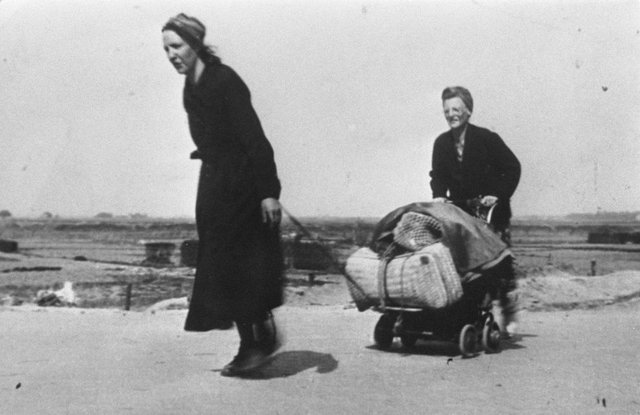
Image CC BY-SA 3.0 - Source
History
After a failed attempt by the British troops for the liberation of Holland, the Dutch railway workers supported the government in the implementation of a strike with the aim of preventing the refuelling of the Germans. The German authorities reacted by placing an embargo on transport throughout the country. However, at the beginning of November the embargo was slightly loosened, and the German authorities allowed food supplies via water transport. Unfortunately, what had not been calculated was that the coming winter would have proved unusually rigid and precocious. The channels through which the Dutch received supplies froze and were no longer navigable. The food reserves were quickly depleted and for 7 months the population had to endure a serious food shortage. It is estimated that perished 18,000 civilians and that the caloric intake for adults from 1800 kilocalories fell to 580 at the end of February 1945.
Obviously, among the many people who suffered from hunger, there were a number of pregnant women, and it is estimated that about 40,000 mothers led part of the wait under extremely stressful food regimes; in our day it is possible to study what happened to the children of the winter of hunger.
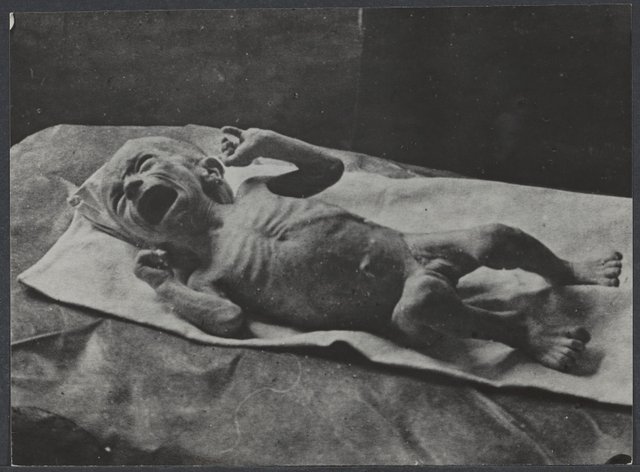
Image CC0 1.0 Universal - Source
Scientific investigations
The scientific research in this regard was somehow facilitated by the large amount of documents drawn up at the time and today it is possible to retrieve many documents regarding this event, and by the fact that the people surveyed are in most cases still living, as they are the children of the women who suffered hunger in those months; in fact, they are people who today are between 40 and 60 years old.
The Dutch health authorities updated the health records of all citizens at the end of the war and this allowed scientists to measure the effects of famine on human health. Numerous epidemiological studies were subsequently carried out to observe how maternal malnutrition could have affected the development and therefore the health of the fetus. In 1989 David Barker conducted a survey on the association of parameters and diseases on the medical records of over 5600 subjects (males) born in Hetfordshire between 1911 and 1930. In general, he observed a positive correlation between birth weight and health status during childhood. This means that a fetus exposed to malnutrition during pregnancy has an unsuitable state of health. Surprisingly in this study it was found that subjects underweight at birth had a risk of death for adult ischemic heart disease three times highe than those with average or above average weights.
Barker then repeated the study, this time basing it on 4600 subjects (males) born at the hospital in Helsinki between 1934 and 1944. Again, a below-average birth weight caused by exposure to malnutrition turned out to be an important risk factor. for the development of coronary artery disease. An association between low birth weight and other diseases was identified again, including cerebral ischemia and diabetes in this case.
Thanks to the data provided by these experiments, a hypothesis was born, the hypothesis of the "thrifty phenotype": the environment in which the fetus develops determines the activation of alternative patterns of development. This idea suggests that in the embryo there are genetic regulatory regions that are activated in specific stages of pregnancy and possibly in the first months or years of life. It would also seem that the uterine environment is able to influence and influence the genetic activity in the various stages of embryonic development.
In particular, in the case of the phenomenon observed by Barker, the hypothesis that is proposed is that the conditions of intrauterine development profoundly influence the control of the metabolism of the child and therefore, of the adult. All this will be reflected in a propensity to accumulate various types of reserves (in particular fats, including cholesterol). In other words, the 'undernourished' fetus would develop into an adult characterized by a "thrifty phenotype".
The thrifty phenotype
To test the hypothesis of the thrifty phenotype numerous experimental studies have been carried out, through the use of different animal models.
Some mouse females have been subjected to a low protein diet at certain stages of pregnancy and the offspring thus obtained showed a high risk of developing hypertension in adulthood. Furthermore, a poor diet seems to be related to the manifestation of an adult phenotype characterized by a reduced number of nephrons in the kidneys. This feature is also found in men suffering from hypertension. This suggests the possibility that a marked food deficiency may result in the death of some kidney cells in development by activation of glucocorticoids. Hypertension usually occurs after age 40 and is a risk factor for various diseases after age 45.
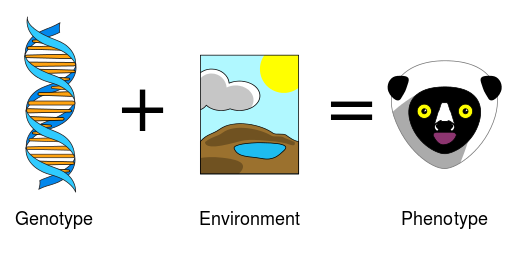
Image CC BY-SA 4.0 - Source
Therefore, in the case of food deficiency, according to the hypothesis of the thrifty phenotype, the few resources available to the fetus, necessary for its development, could preferably be destined in regions other than the kidney, which probably does not represent an essential organ from the ontogenetic point of view. This could result in the previously observed phenotype and other micro-anatomical alterations also documented for pancreas, heart and liver. In particular, in the pancreas there is a reduction of beta cells, a risk factor for type 2 diabetes and a metabolic syndrome (a metabolic disorder characterized by high glucose levels and obesity).
Micro-anatomical changes at the liver level have been studied in rats undernourished before birth, in which a change in the histological structure of the liver is observed. In particular, there is an increase in glucose-producing liver cells and a decrease in liver cells involved in glycogen synthesis. As with nephrons, these changes are thought to be coordinated by glucocorticoids stimulated by malnutrition and occurring to conserve resources. This process, despite being able to conserve the few resources to allow the development of the embryo, can make the individual more susceptible to subsequent disorders.
Although this may seem a "suicidal" strategy from the medical point of view, it is clear that in an evolutionary view the "choice" of the organism is sensible: I put the long-term health of the individual in a possible risk, to guarantee the birth and an initial development.
How it happens
Thanks to the studies conducted on the first and the second generation of mothers exposed to Dutch famine, nowadays all pregnant women are supplemented with folic acid, betaine and choline along with vitamin B6 and B12.
You may wonder how this is correlated with the Winter of Hunger, well, in the aforementioned studies it has been shown that the gene involved in the "obesity-predisposed" phenotype is IGF2, a maternal imprinted gene encoding for a growth factor crucial in baby growth and its size. In particular it has been shown that the children of the mother that experience the Dutch famine, had this gene hypomethylated compared to children conceived before and after the famine. The hypomethylation of two particular regions (the fourth and the sixth) would determine a partial diploidy of this gene, determine an increase of size of the babies and the consequent predisposition to obesity, cardiovascular disease, cancer and diabetes.
By investigating further,ù the mechanism that lead to the hypomethylation of this region, it has been demonstrated that supplementation of methyl donors such as folate, betaine and choline and of cofactors important in the folate pathway and in the methylation pathway (B6 and B12) rescued the methylation state in mice born from mother with a minimal supplementation of food.
The rationale behind this is this: in order to correctly imprint and methylate genes, methyl groups are needed along with functioning DNA methyl-transferase; by having a poor diet, methyl donors are in low number and not sufficient to correctly methylate imprinted genes such as IGF2, this lead to partial diploidy for these particular genes and this will lead to mutated phenotype.
Phenotypic plasticity
Even today, the appearance of these new characters promoted by alterations in development, following a change in the environment (in this case the intrauterine environment), can be considered as mechanisms of phenotypic plasticity. Therefore, following these mechanisms, a single (unalterable) genotype can result in the appearance of different (alterable) phenotypes, under the influence of different external conditions. At the base of phenotypic plasticity there are various factors including the epigenetic processes we talked about long ago and that you can find in this post: changes in gene expression that involve different morphological traits, despite the gene sequences remain unchanged.
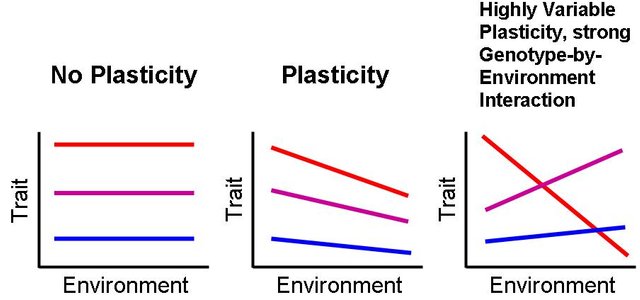
Image CC BY-SA 3.0 - Source
Numerous studies are still underway, but it seems that the inheritance of the modifications induced by the environment is able to reach, at least in man, up to the third generation after the subject concerned. There are in fact some mechanisms, probably born to guarantee to the successive generations a sort of epigenetic "independence" compared to the previous ones, that are able to reset the epigenetic code bringing it back to a basal condition. In other organisms, instead, these mechanisms are absent, and experiments conducted on nematodes have shown with epigenetic modifications they are able to transmit for tens of generations.
Conclusions
Returning to the events narrated at the beginning of this article, one can observe how the severity of alterations is greater in fetuses exposed to malnutrition in earlier stages. In particular, exposure during the initial phases seems to involve alterations in glucose metabolism and lipid profile, tendency to obesity to coronary artery disease, breast cancer and depression.
Fetuses exposed during the intermediate stages, on the other hand, appear to exhibit an impaired glucose metabolism, pulmonary and renal disease in adulthood.
Finally, fetuses exposed during the final stages show the milder symptoms, usually showing an altered glucose metabolism.
The most curious case remains that of fetuses exposed during the last month of pregnancy which show a normal weight at birth and, in most cases, do not show evident clinical signs during their life. As adults, however, they often generate underweight children and tend to develop metabolic dysfunctions. It seems therefore confirmed that part of the epigenetic modifications is transmitted to the third generation.
To date it is not possible to quantitatively measure the role that mechanisms such as phenotypic plasticity and epigenetics play in evolution; most of our observations are indeed qualitative. Events such as the one described, however, represent in some ways a natural experiment that is difficult to repeat and surely the data that future generations will provide will allow us to acquire more information on the inheritance of certain characters and how they can play a fundamental role in evolution.

Immagine CC0 Creative Commons, si ringrazia @mrazura per il logo ITASTEM.
CLICK HERE AND VOTE FOR DAVINCI.WITNESS
Bibliografia
- Farooq Ahmed (2010). Epigenetics: Tales of adversity.
https://www.nature.com/articles/468S20a - Ernst J. Franzek, Niels Sprangers. A. Cecile. J. W. Janssens, Cornelia M. Van Duijn, Ben J. M. Van De Wetering (2008). Prenatal exposure to the 1944–45 Dutch ‘hunger winter’ and addiction later in life.
https://doi.org/10.1111/j.1360-0443.2007.02084.x - Bastiaan T. Heijmans, Elmar W. Tobi, Aryeh D. Stein, Hein Putter, Gerard J. Blauw, Ezra S. Susser, P. Eline Slagboom, and L. H. Lumey (2008). Persistent epigenetic differences associated with prenatal exposure to famine in humans.
https://doi.org/10.1073/pnas.0806560105 - An introduction about epigenetics.

Poco prima della fine della Seconda Guerra Mondiale, nell’inverno tra il 1944 e il 1945, nei paesi dell’Olanda Occidentale ancora stretti dall’assedio tedesco, le truppe del Reich decisero di bloccare qualsiasi rifornimento diretto alla popolazione, causando quello che oggi è conosciuto come l’Hongerwinter, l’inverno della fame, di cui tutt’ora si possono osservare gli effetti.
Nonostante questi fatti possano sembrarci lontani, e poco collegati con il presente, alcuni recenti lavori scientifici hanno messo in evidenza come le conseguenze di quel periodo drammatico siano alla base di alcune patologie e disfunzioni riscontrabili nelle generazioni di oggi.

Image CC BY-SA 3.0 - Source
La storia
Dopo un tentativo fallito delle truppe britanniche per la liberazione dell’Olanda, i ferrovieri olandesi sostennero il governo nella messa in atto di uno sciopero con il fine di impedire il rifornimento dei tedeschi. Le autorità tedesche reagirono ponendo un embargo sui trasporti nell’intero paese. Tuttavia, all’inizio del mese di novembre l’embargo fu leggermente allentato e le autorità tedesche permisero rifornimenti di cibo attraverso trasporti via acqua. Purtroppo, quello che non era stato calcolato era che l’inverno ormai prossimo si sarebbe dimostrato insolitamente rigido e precoce. I canali attraverso i quali gli olandesi ricevevano i rifornimenti si congelarono e non furono più navigabili. Le riserve di cibo si esaurirono rapidamente e per 7 mesi la popolazione dovette sopportare una grave carenza di generi alimentari. Si conta che perirono 18000 civili e che l’apporto calorico per gli adulti da 1800 chilocalorie scesero a 580 alle fine del mese di febbraio 1945.
Ovviamente, tra le tante persone che soffrirono la fame vi era un certo numero di donne in gravidanza, e si calcola che circa 40000 mamme condussero parte dell’attesa sottoposte a regimi alimentari estremamente stressanti; ai giorni nostri è possibile studiare ciò che è successo ai nascituri dell’inverno della fame.

Image CC0 1.0 Universal - Source
Indagini scientifiche
La ricerca scientifica a riguardo è stata in qualche modo facilitata dalla grande mole di documenti stilati all’epoca e oggi è possibile recuperare molti documenti riguardanti questo evento, e dal fatto che le persone oggetto dell’indagine sono nella maggior parte dei casi tutt’ora viventi, in quanto si tratta dei figli delle donne che soffrirono la fame in quei mesi; si tratta infatti di persone che oggi hanno età comprese tra i 40 e i 60 anni.
Le autorità sanitarie olandesi aggiornarono i registri sanitari di tutti i cittadini alla fine della guerra e questo permise agli scienziati di misurare gli effetti della carestia sulla salute umana. Numerosi studi epidemiologici sono stati effettuati successivamente per osservare come la malnutrizione materna potesse essersi ripercossa sullo sviluppo e pertanto, sulla salute del feto. Nel 1989 David Barker diresse un’indagine sull’associazione di parametri e patologie sulle cartelle cliniche di oltre 5600 soggetti (maschi) nati nell’Hetfordshire tra il 1911 e il 1930. In generale osservò una correlazione positiva tra peso alla nascita e stato di salute durante l’infanzia. Questo significa che un feto esposto a malnutrizione durante la gravidanza presenta uno stato di salute non idoneo. Sorprendentemente in questo studio venne constatato che soggetti sottopeso alla nascita presentavano un rischio di morte per cardiopatia ischemica in età adulta tre volte superiore rispetto ai soggetti con pesi nella media o superiori alla media.
Barker ripeté successivamente lo studio, questa volta basandolo su 4600 soggetti (maschi) nati all’ospedale di Helsinki tra il 1934 e il 1944. Di nuovo, un peso sotto la media alla nascita causato da esposizione a malnutrizione risultò essere un importante fattore di rischio per lo sviluppo di coronaropatie. Venne nuovamente identificata un’associazione tra basso peso alla nascita ed altre patologie, tra cui in questo caso ischemie cerebrali e diabete.
Grazie ai dati forniti da questi esperimenti nacque un’ipotesi, l’ipotesi del “fenotipo risparmiatore”: l’ambiente in cui si sviluppa il feto determina l’attivazione di pattern alternativi di sviluppo. Questa idea suggerisce che nell’embrione vi siano regioni genetiche regolative che vengono attivate in specifici stadi della gravidanza ed eventualmente nei primi mesi/anni di vita. Sembrerebbe inoltre che l’ambiente uterino sia in grado di condizionare e influenzare l’attività genetica nei vari stadi dello sviluppo embrionale.
In particolare, nel caso del fenomeno osservato da Barker, l’ipotesi che viene proposta è che le condizioni di sviluppo intrauterino influenzino profondamente il controllo del metabolismo del bambino e quindi, dell’adulto. Tutto ciò si rifletterà in una propensione ad accumulare vari tipi di riserve (in particolare grassi, tra cui colesterolo). In altri termini, il feto ‘denutrito’ si svilupperebbe in un adulto caratterizzato da un “fenotipo risparmiatore”.
Il fenotipo risparmiatore
Per verificare l’ipotesi del fenotipo risparmiatore sono stati effettuati numerosi studi sperimentali, attraverso l’uso di diversi modelli animali.
Alcune femmine di topo sono state sottoposte a una dieta povera di proteine in determinate fasi della gravidanza e la prole così ottenuta ha evidenziato un rischio elevato di sviluppare ipertensione in età adulta. Inoltre, una dieta povera sembra essere correlata alla manifestazione di un fenotipo adulto caratterizzato da un numero ridotto di nefroni nei reni. Questa caratteristica è rinvenuta anche in uomini affetti da ipertensione. Questo suggerisce la possibilità che una carenza alimentare marcata possa provocare la morte di alcune cellule dei reni in via di sviluppo mediante l’attivazione dei glucocorticoidi. L’ipertensione solitamente si manifesta dopo i 40 anni ed è un fattore di rischio per varie patologie dopo i 45 anni.

Image CC BY-SA 4.0 - Source
Quindi, in caso di carenza alimentare, secondo l’ipotesi del fenotipo risparmiatore, le poche risorse disponibili per il feto, necessarie per il suo sviluppo potrebbero essere destinate preferibilmente in regioni diverse dal rene, che probabilmente non rappresenta dal punto di vista ontogenetico un organo fondamentale. Questo potrebbe comportare il fenotipo osservato precedentemente e altre alterazioni micro-anatomiche documentate anche per pancreas, cuore e fegato. In particolare, nel pancreas si osserva una riduzione di cellule beta, fattore di rischio per diabete di tipo 2 e sindrome metabolica (un disturbo metabolico caratterizzato da livelli di glucosio alti e obesità).
Modificazioni micro-anatomiche a livello del fegato sono state studiate in ratti denutriti prima della nascita, in cui si osserva una modifica nella struttura istologica del fegato. In particolare, si osserva un aumento di cellule del fegato che producono glucosio e una diminuzione di cellule epatiche coinvolte nella sintesi di glicogeno. Come nel caso dei nefroni, si ritiene che questi cambiamenti vengano coordinati dai glucocorticoidi stimolati dalla malnutrizione e che avvengano per conservare le risorse. Questo processo, nonostante sia atto a conservare le poche risorse per permettere lo sviluppo dell’embrione, può rendere l’individuo più suscettibile a successivi disturbi.
Per quanto questa possa apparire una strategia “suicida” dal punto di vista medico, è chiaro che in ottica evoluzionistica la “scelta” dell’organismo è invece sensata: metto in possibile rischio la salute a lungo termine dell’individuo, per garantirne la nascita e uno sviluppo iniziale.
Come accade
Grazie agli studi condotti sulla prima e sulla seconda generazione di madri esposte alla carestia olandese, oggi tutte le donne incinte sono integrate con acido folico, betaina e colina insieme a vitamina B6 e B12.
Questo perché negli studi sopra citati è stato dimostrato che il gene coinvolto nel fenotipo "obesità-predisposto" è IGF2, un gene impresso materno che codifica per un fattore di crescita cruciale per il bambino, in quanto in grado di influenzarne sviluppo e dimensioni. In particolare, è stato dimostrato che i figli delle madri che hanno sperimentato la fame in Olanda avevano questo gene ipometilato rispetto ai bambini concepiti prima e dopo la carestia. L'ipometilazione di due particolari regioni (la quarta e la sesta) determinerebbe una parziale diploidia di questo gene, causando un aumento delle dimensioni dei bambini e la conseguente predisposizione all'obesità, malattie cardiovascolari, cancro e diabete.
Indagando ulteriormente il meccanismo che porta all'ipometilazione di questa regione, è stato dimostrato che l'integrazione di donatori metilici quali folato, betaina e colina e di cofattori importanti nella via del folato e nella via di metilazione (B6 e B12) riesce a prevenire l’errata metilazione dei geni interessati nei topi nati da madri esposte a situazioni di carestia.
La logica alla base di questo fenomeno, non immediatamente comprensibile, è la seguente: per poter metilare correttamente il genoma sono necessari gruppi metilici, insieme alla metil transferasi del DNA; in una dieta povera, i donatori di metile sono in numero basso e non sufficienti per metilare correttamente un gran numero di geni come IGF2, questo porta a diploidia (o a sovra-espressione) parziale per questi particolari geni e questo porterà a fenotipo mutato.
Plasticità fenotipica
Tutt’oggi si ritiene che la comparsa di questi nuovi caratteri promossi da alterazioni nello sviluppo, a seguito di un cambiamento nell’ambiente (in questo caso l’ambiente intrauterino) possano essere considerati meccanismi di plasticità fenotipica. Quindi, seguendo questi meccanismi, un singolo genotipo (inalterabile) può comportare la comparsa di diversi fenotipi (alterabili), sotto l’influenza di diverse condizioni esterne. Alla base della plasticità fenotipica vi sono vari fattori tra cui i processi epigenetici di cui abbiamo parlato tempo fa e che potete trovare in questo post: cambiamenti nell’espressione genica che comportano tratti morfologici differenti, nonostante le sequenze geniche rimangano invariate.

Image CC BY-SA 3.0 - Source
Numerosi studi sono tutt’ora in corso, ma sembra che l’ereditarietà delle modificazioni indotte dall’ambiente sia in grado di estendersi, almeno nell’uomo, fino alla terza generazione dopo il soggetto interessato. Esistono infatti alcuni meccanismi, probabilmente nati per garantire alle generazioni successive una sorta di “indipendenza” epigenetica rispetto alle precedenti, che sono in grado di resettare il codice epigenetico riportandolo ad una condizione basale. In altri organismi, invece, questi meccanismi sono assenti ed esperimenti condotti sui nematodi hanno evidenziato con le modificazioni epigenetiche siano in grado di trasmettersi anche per decine di generazioni.
Conclusioni
Tornando agli eventi narrati all’inizio di questo articolo, si può osservare come la gravità delle alterazioni sia maggiore in feti esposti a malnutrizione in stadi più precoci. In particolare, un’esposizione durante le fasi iniziali sembra comportare alterazioni nel metabolismo del glucosio e nel profilo lipidico, tendenza all’obesità a coronaropatie, tumore al seno e depressione.
Feti esposti durante gli stadi intermedi, invece, sembra mostrare in età adulta un metabolismo alterato del glucosio, malattie polmonari e renali.
Feti esposti durante gli stadi finali mostrano infine i sintomi più lievi, evidenziando solitamente un metabolismo alterato del glucosio.
Il caso più curioso rimane quello dei feti esposti durante l’ultimo mese di gravidanza che mostrano alla nascita un peso nella norma e, nella maggior parte dei casi, non manifestano segni clinici evidenti durante la loro vita. Da adulti, però, generano in molti casi figli sottopeso e con la tendenza allo sviluppo di disfunzioni metaboliche. Sembra quindi confermato che una parte delle modificazioni epigenetiche viene trasmessa alla terza generazione.
Ad oggi non è possibile misurare quantitativamente il ruolo che meccanismi come la plasticità fenotipica e l’epigenetica giocano nell’evoluzione; la maggior parte delle nostre osservazioni sono infatti di tipo qualitativo. Avvenimenti come quello raccontato, però, rappresentano per certi versi un esperimento naturale difficilmente ripetibili e sicuramente i dati che ci forniranno le generazioni future permetteranno di acquisire maggiori informazioni relative all’ereditarietà di determinati caratteri e di come questi possano giocare un ruolo fondamentale nell’evoluzione.

Immagine CC0 Creative Commons, si ringrazia @mrazura per il logo ITASTEM.
CLICK HERE AND VOTE FOR DAVINCI.WITNESS
Bibliografia
- Farooq Ahmed (2010). Epigenetics: Tales of adversity.
https://www.nature.com/articles/468S20a - Ernst J. Franzek, Niels Sprangers. A. Cecile. J. W. Janssens, Cornelia M. Van Duijn, Ben J. M. Van De Wetering (2008). Prenatal exposure to the 1944–45 Dutch ‘hunger winter’ and addiction later in life.
https://doi.org/10.1111/j.1360-0443.2007.02084.x - Bastiaan T. Heijmans, Elmar W. Tobi, Aryeh D. Stein, Hein Putter, Gerard J. Blauw, Ezra S. Susser, P. Eline Slagboom, and L. H. Lumey (2008). Persistent epigenetic differences associated with prenatal exposure to famine in humans.
https://doi.org/10.1073/pnas.0806560105 - Introduzione all’epigenetica.
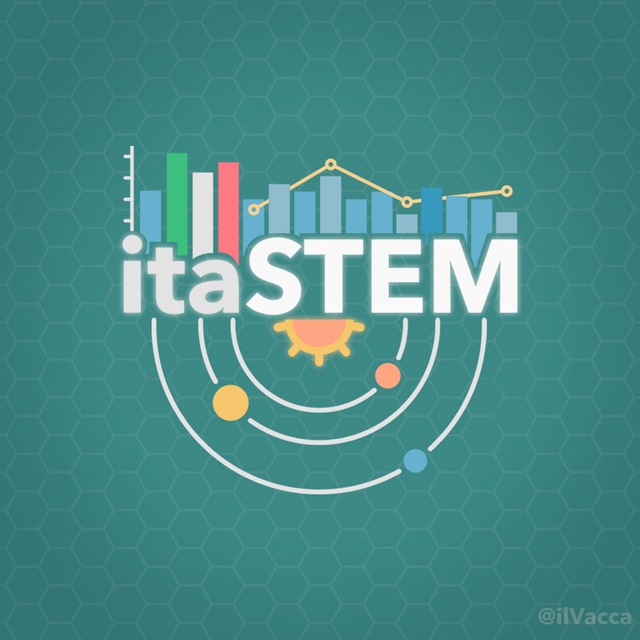
Logo creato da @ilvacca
really fascinating! thank you!
when you say it can go down to as much as the third generation its because we have information on 3 generations and it could go on for many more or does it stop there and we checked the 4th generation and prove that?
its crazy to think that something that happened to the grandparents can effect the health of their grandchildren... amazing
Thank you! :D
The question is very interesting, but there is no certain answers. To date we have not yet been able to observe the effects on a hypothetical fourth generation in humans, and certainly will be done in the future. But animal models seem to suggest that there are mechanisms at the level of the zygote that prevent the passage of epigenetic information beyond the third generation (at least in mammals).
I think there is still so much to discover about it, we know very little.
Siete sempre al top. Anche questa volta lo avete dimostrato ampiamente. Ottimo lavoro!
Un saluto, nicola
Grazie @knfitaly ;) sempre gentilissimo! Si fa il possibile, nonostante ogni tanto scappi qualche svista...
Molto interessante come studio spaghettiscience.
Complimenti 👍
Post ottimo , di qualitá e molto interessante.
Interessante come sempre! Complimenti!
E pensare che a volte non comprendiamo di essere tanto intimamente legati all'ambiente che ci circonda! Immagino che in futuro si riuscirà a "quantificare" per bene ciò che oggi rimane una conoscenza di carattere parzialmente qualitativo ma che è comunque considerata certa. E si potrebbero dare alle donne ulteriori strumenti per affrontare la gravidanza con consapevolezza, limitando i rischi al massimo per il nascituro. Un sistema di prevenzione basato su queste premesse potrebbe essere molto utile e significativo, ma al contempo anche un po' stressante per le mamme xD
Davvero! Anche perché a volte ci perdiamo dietro a mille metodi più o meno funzionanti dimenticandoci poi delle cose davvero importanti... Ma sarebbe già un'ottima cosa che se l'umanità imparasse da avvenimenti come questi e non ripetesse più gli stessi errori (orrori?); ma mi pare che sia una speranza vana...
Hi @spaghettiscience!
Your post was upvoted by utopian.io in cooperation with steemstem - supporting knowledge, innovation and technological advancement on the Steem Blockchain.
Contribute to Open Source with utopian.io
Learn how to contribute on our website and join the new open source economy.
Want to chat? Join the Utopian Community on Discord https://discord.gg/h52nFrV